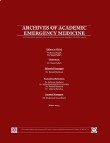Management of Preventable Deaths due to Road Traffic Injuries in Prehospital Phase; a Qualitative Study
Author(s):
Article Type:
Research/Original Article (دارای رتبه معتبر)
Abstract:
Introduction
Prehospital care plays an important role in decreasing the number of deaths due to road traffic injuries (RTIs). This study aimed to identify the challenges of preventable deaths due to RTIs in the prehospital phase based on the attitudes of stakeholders.
Methods
Conventional content analysis of qualitative study was used to analyze the data. The participants were 24 RTI prevention experts from fire-fighting organization, traffic police, the Red Crescent, Emergency Medical Services staff, emergency medicine specialists, and hospital emergency nurses who were selected by means of purposive sampling. Data were collected using unstructured interviews and analyzed by means of data coding, followed by extracting sub-categories, and main categories.
Results
Six main categories were extracted as the major challenges of preventable deaths in RTIs in the prehospital phase including “poor management of the crash scene” with two subcategories of lack of rapid access to the patient and lack of scene safety, “lack of adequate rules and regulations” with two subcategories of lack of protocols and guidelines and lack of clear duties checklists, “poor management of time” with two subcategories of elongated response time at the crash scene and elongated time of victim transport, “low quality of training” with two subcategories of insufficient training of Emergency Medical Services (EMS) staff and inadequate public training, “poor communication and coordination” with two subcategories of poor communication of EMS staff and lack of uniform commandership at the crash scene, and “low quality of victim management” with two subcategories of low quality of clinical care and lack of accurate clinical assessment.
Conclusion
The following measures are necessary to reduce preventable deaths due to RTIs in the prehospital phase: accurate clinical assessment of the victim on the scene, provision of high quality and accurate clinical care, enforcement of legal obligations and using protocols in the field of victim management, coordination of the involved organizations through identifying the duties and responsibilities of each organization, and full management of the crash scene by assigning a unique commander to each unit and creation of the highest level of safety on crash scene.Keywords:
Language:
English
Published:
Archives of Academic Emergency Medicine, Volume:7 Issue: 1, 2019
Page:
18
magiran.com/p2021453
دانلود و مطالعه متن این مقاله با یکی از روشهای زیر امکان پذیر است:
اشتراک شخصی
با عضویت و پرداخت آنلاین حق اشتراک یکساله به مبلغ 1,390,000ريال میتوانید 70 عنوان مطلب دانلود کنید!
اشتراک سازمانی
به کتابخانه دانشگاه یا محل کار خود پیشنهاد کنید تا اشتراک سازمانی این پایگاه را برای دسترسی نامحدود همه کاربران به متن مطالب تهیه نمایند!
توجه!
- حق عضویت دریافتی صرف حمایت از نشریات عضو و نگهداری، تکمیل و توسعه مگیران میشود.
- پرداخت حق اشتراک و دانلود مقالات اجازه بازنشر آن در سایر رسانههای چاپی و دیجیتال را به کاربر نمیدهد.
In order to view content subscription is required
Personal subscription
Subscribe magiran.com for 70 € euros via PayPal and download 70 articles during a year.
Organization subscription
Please contact us to subscribe your university or library for unlimited access!


